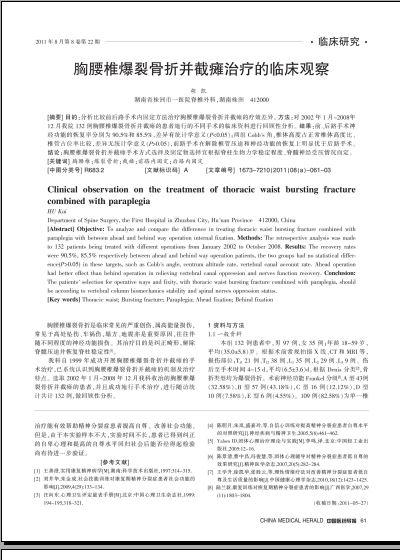胸腰椎爆裂骨折并截瘫治疗的临床观察(1)
 |
| 第1页 |
参见附件(3112KB,3页)。
[摘要] 目的:分析比较前后路手术内固定方法治疗胸腰椎爆裂骨折并截瘫的疗效差异。方法:对2002年1月~2008年12月我院132例胸腰椎爆裂骨折并截瘫的患者施行的不同手术的临床资料进行回顾性分析。结果:前、后路手术神经功能的恢复率分别为90.5%和85.5%,差异有统计学意义(P<0.05);两组Cobb's角、椎体高度占正常椎体高度比、椎管占位率比较,差异无统计学意义(P>0.05),前路手术在解除椎管压迫和神经功能的恢复上明显优于后路手术。结论:胸腰椎爆裂骨折并截瘫手术方式选择及固定物选择宜根据脊柱生物力学稳定程度、脊髓神经受压情况而定。
[关键词] 胸腰椎;爆裂骨折;截瘫;前路内固定;后路内固定
[中图分类号] R683.2[文献标识码]A [文章编号]1673-7210(2011)08(a)-061-03
Clinical observation on the treatment of thoracic waist bursting fracture combined with paraplegia
HU Kai
Department of Spine Surgery, the First Hospital in Zhuzhou City, Hu'nan Province 412000, China
[Abstract] Objective: To analyze and compare the difference in treating thoracic waist bursting fracture combined with paraplegia with between ahead and behind way operation internal fixation. Methods: The retrospective analysis was made to 132 patients being treated with different operations from January 2002 to October 2008. Results: The recovery rates were 90.5%, 85.5% respectively between ahead and behind way operation patients, the two groups had no statistical difference(P>0.05) in these targets, such as Cobb's angle, centrum altitude rate, vertebral canal account rate. Ahead operation had better effect than behind operation in relieving vertebral canal oppression and nerves function recovery. Conclusion: The patients' selection for operative ways and fixity, with thoracic waist bursting fracture combined with paraplegia, should be according to vertebral column biomechanics stability and spinal nerves oppression status.
[Key words] Thoracic waist; Bursting fracture; Paraplegia; Ahead fixation; Behind fixation
胸腰椎爆裂骨折是临床常见的严重创伤,属高能量损伤,常见于高处坠伤、车祸伤,塌方、地震亦是重要原因,往往伴随不同程度的神经功能损伤。其治疗目的是纠正畸形,解除脊髓压迫并恢复脊柱稳定性[1]。
我科自1999年成功开展胸腰椎爆裂骨折并截瘫的手术治疗,已系统认识到胸腰椎爆裂骨折并截瘫的机制及治疗特点。选取2002年1月~2008年12月我科收治的胸腰椎爆裂骨折并截瘫的患者,并且成功施行手术治疗,进行随访统计共计132例,做回顾性分析。
1 资料与方法
1.1一般资料
本组132 例患者中,男 97 例,女35 例;年龄18~59岁,平均(35.0±5.8)岁。根据术前常规拍摄X线、CT和MRI等,损伤部位:T11 21 例、T12 38 例、L1 35 例、L2 29例、L3 9例。伤后至手术时间 4~15 d,平均(6.5±3.6)d。根据 Denis 分类[2],骨折类型均为爆裂骨折。术前神经功能Frankel分级[3],A 型43例(32.58%),B 型57例(43.18%),C 型16 例(12.12%),D 型10例(7.58%),E 型6例(4.55%)。109例(82.58%)为单一椎体的骨折,23例(17.42%)为多节段相邻椎体骨折脱位。骨折椎体高度平均丢失61.4%,椎管占位平均达40.7%,伤椎上下终板夹角平均38.2°。依据不同的临床特点,63例选择前路手术(A组),男50例,女13例,年龄19~57岁,平均(34.7±5.7)岁,伤后至手术时间平均(6.7±3.3)d;69例选择后路手术,男47例,女12例,年龄18~59岁,平均(35.1±5.2)岁,伤后至手术时间平均(6.1±3.9)d ......
您现在查看是摘要介绍页,详见PDF附件(3112KB,3页)。